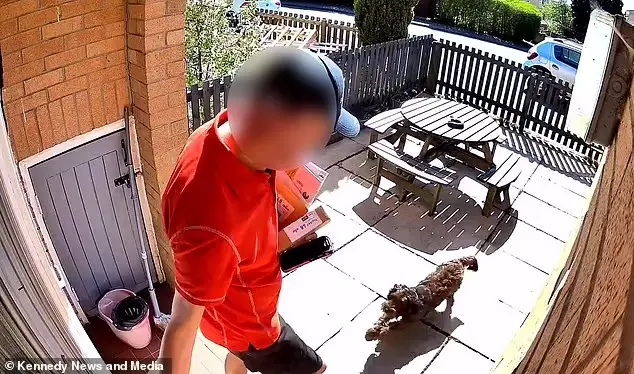NOTE:VIDEO AT THE END OF ARTICLE.
Security Footage Reveals Postal Worker’s Controversial Interaction with Customer’s Pet
Executive Summary
A recent incident involving a Royal Mail postal worker and a customer’s puppy in Leeds has sparked significant public debate about appropriate conduct during delivery operations and the complex relationship between postal workers and domestic animals. The incident, captured on residential security cameras, has raised important questions about workplace safety protocols, animal welfare, and the responsibilities of both postal services and pet owners in ensuring safe delivery environments.
Incident Overview
On April 17, 2024, security camera footage captured an interaction between a Royal Mail postal worker and a cockapoo puppy named Bella at a residence in Leeds, West Yorkshire. The incident occurred when the puppy, owned by Nikki Walker, exited through a ground-floor window after hearing the garden gate open during a routine mail delivery.

The footage shows the postal worker making contact with the approaching puppy using his foot, an action that has generated considerable controversy and public discussion about appropriate responses to animal encounters during delivery operations. The incident has highlighted the ongoing challenges faced by postal workers regarding animal interactions and the protocols established to ensure both worker safety and animal welfare.
Detailed Account of Events
The Initial Encounter

Nikki Walker, who was working from home at the time of the incident, reported hearing what she described as a “yelp of pain” from her puppy, which prompted her to investigate the situation immediately. Upon approaching the postal worker to inquire about the incident, she was reportedly met with defensive responses and verbal aggression when she mentioned her intention to review security camera footage.
The homeowner’s account suggests that the postal worker initially denied any physical contact with the animal, claiming instead that he had merely raised his leg defensively to prevent the puppy from jumping. However, subsequent review of the security footage contradicted this explanation, showing what appeared to be deliberate contact between the worker’s boot and the animal.
Security Camera Evidence
The residential security system captured the entire interaction, providing visual documentation of the encounter. According to reports, the footage shows the cockapoo approaching the postal worker in what witnesses described as a friendly manner, with tail wagging and no signs of aggressive behavior. The video evidence has become central to the subsequent investigation and public discussion of the incident.
The availability of high-quality security footage has enabled detailed analysis of the encounter, including the puppy’s behavior leading up to the incident and the postal worker’s response. This documentation has proven crucial in determining the appropriate course of action for all parties involved.
Immediate Aftermath
Following the incident, the puppy reportedly exhibited behavioral changes consistent with stress or trauma, including seeking shelter and displaying what the owner interpreted as fearful behavior. The animal’s immediate retreat to indoor spaces and subsequent cowering behavior suggested that the encounter had a significant impact on the pet’s emotional state.
The homeowner’s emotional response to reviewing the security footage reflects the strong bond between pet owners and their animals, as well as the distress caused by witnessing what she perceived as an unprovoked attack on her pet. The incident has had lasting effects on both the animal and the household, influencing their relationship with postal services and their confidence in delivery safety protocols.
Institutional Response and Policy Implications
Royal Mail’s Official Position
Royal Mail has responded to the incident by emphasizing their commitment to employee safety while acknowledging the concerns raised about the specific encounter. The organization has highlighted their comprehensive safety protocols and the statistical reality of animal-related incidents affecting postal workers throughout the United Kingdom.
According to Royal Mail data, postal workers experience over 2,200 dog-related incidents annually, with some resulting in serious injuries that require medical treatment and extended recovery periods. This context provides important background for understanding the challenges faced by delivery personnel and the defensive measures they may feel compelled to employ during animal encounters.
The postal service has implemented various protocols designed to protect workers while maintaining service quality, including guidance on appropriate responses to animal encounters and procedures for addressing situations where pet behavior may pose safety concerns.
Service Suspension and Safety Measures
In response to the incident, Royal Mail has temporarily suspended delivery services to the affected address, citing concerns about ongoing safety risks. The organization has requested that the homeowner implement additional security measures, specifically the installation of enhanced fencing to better contain the pet during delivery times.
This response reflects standard industry protocols for addressing animal-related safety concerns, though it has generated additional controversy regarding the proportionality of the measures and the financial burden placed on customers. The estimated £80 cost for fence installation represents a significant expense for homeowners, particularly when they dispute the underlying justification for such measures.
The postal service’s approach demonstrates the complex balance between maintaining service delivery and ensuring worker safety, while also addressing customer concerns and public relations challenges.
Public Response and Social Media Reaction
Community Outrage and Support
The incident has generated significant public attention, particularly through social media platforms where users have expressed strong opinions about the postal worker’s conduct. Many commentators have characterized the action as excessive and inappropriate, calling for disciplinary measures and policy changes to prevent similar incidents.
The emotional nature of animal welfare issues has contributed to the intensity of public response, with many individuals expressing personal connections to similar situations involving their own pets. This emotional resonance has amplified the discussion beyond the specific incident to broader questions about animal protection and appropriate conduct by service personnel.
Public sentiment has largely supported the pet owner’s position, with many individuals sharing similar experiences and expressing concerns about the safety of their own animals during delivery operations.
Professional and Ethical Considerations
The incident has prompted discussion within professional communities about appropriate training for delivery personnel regarding animal encounters. Safety experts and animal welfare advocates have used the incident as an opportunity to highlight best practices for managing human-animal interactions in service environments.
The debate has extended to questions about proportional response, de-escalation techniques, and the availability of non-violent alternatives for managing animal encounters during delivery operations. These discussions reflect broader societal concerns about animal welfare and the responsibilities of service providers in ensuring safe interactions.
Industry Context and Statistical Analysis
National Trends in Postal Worker Safety
The incident occurs within a broader context of ongoing challenges regarding postal worker safety and animal encounters. Statistical data from Royal Mail and other delivery services indicates that animal-related incidents represent a significant occupational hazard for delivery personnel throughout the United Kingdom.
The more than 2,200 annual incidents reported by Royal Mail represent a substantial safety concern that affects service delivery, worker welfare, and operational costs. These incidents range from minor encounters that cause delays to serious attacks requiring medical intervention and extended absence from work.
Understanding these statistics provides important context for evaluating individual incidents and developing comprehensive policies that address both worker safety and animal welfare concerns.
Comparative Analysis with Other Service Industries
Similar challenges exist across various service industries where personnel regularly interact with domestic animals, including utility workers, emergency services, and home maintenance providers. Examining approaches used in these sectors can provide valuable insights for developing improved protocols and training programs.
Best practices from other industries emphasize the importance of comprehensive training, clear protocols for animal encounters, and equipment designed to minimize risk while avoiding harm to animals. These approaches demonstrate that effective solutions can address multiple stakeholder concerns simultaneously.
Legal and Regulatory Framework
Animal Welfare Legislation
The incident raises questions about compliance with animal welfare legislation and the appropriate legal frameworks for addressing such situations. Current laws provide protection for domestic animals while also recognizing legitimate safety concerns for service personnel.
The complexity of determining appropriate legal responses to such incidents reflects the challenge of balancing competing interests and establishing clear standards for acceptable conduct in animal encounters during service delivery.
Employment Law Considerations
The incident also involves important employment law considerations regarding worker safety, appropriate conduct, and disciplinary procedures. Employers have legal obligations to protect their employees while also ensuring that customer interactions meet professional standards.
The balance between supporting employee safety and addressing customer concerns requires careful consideration of legal requirements, policy implications, and public relations factors.
Resolution and Future Prevention
Current Status and Ongoing Developments
The postal worker involved in the incident has been removed from the affected delivery route, though broader employment consequences remain undetermined pending investigation completion. This interim measure addresses immediate concerns while allowing for comprehensive review of the incident and appropriate response development.
The homeowner continues to seek resolution that addresses her concerns about animal welfare while potentially restoring normal delivery services. The ongoing nature of the dispute reflects the complexity of finding solutions that satisfy all stakeholder interests.
Policy Recommendations and Best Practices
The incident highlights opportunities for improving protocols and training programs to prevent similar situations in the future. Recommended improvements include enhanced animal behavior training for delivery personnel, clearer guidelines for animal encounters, and improved communication protocols with pet owners.
Additional measures might include the development of specialized equipment for managing animal encounters, expanded customer education about pet management during deliveries, and improved incident reporting and response procedures.
Conclusion
The incident involving the Royal Mail postal worker and the customer’s puppy represents a complex intersection of worker safety, animal welfare, and service delivery challenges. While the specific circumstances of this case continue to generate debate, the broader issues it raises are shared across the delivery industry and require thoughtful, comprehensive solutions.
Moving forward, the most effective approaches will likely involve collaboration between postal services, animal welfare organizations, and customer communities to develop protocols that protect both workers and animals while maintaining high-quality service delivery. The incident serves as an important reminder of the need for ongoing attention to these issues and continued improvement in training, policies, and practices.
The resolution of this specific case will likely influence broader industry practices and public expectations regarding animal encounters during service delivery, making it an important precedent for future policy development and implementation.

Adrian Hawthorne is a celebrated author and dedicated archivist who finds inspiration in the hidden stories of the past. Educated at Oxford, he now works at the National Archives, where preserving history fuels his evocative writing. Balancing archival precision with creative storytelling, Adrian founded the Hawthorne Institute of Literary Arts to mentor emerging writers and honor the timeless art of narrative.
